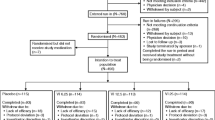Abstract
Early inhaled corticosteroid treatment improves symptom control and pulmonary function in children with asthma; however, long-term safety data are limited in infants and young children. This study assessed the long-term safety of budesonide inhalation suspension (BIS) in young children with persistent asthma. To continue to provide BIS to children who needed it—prior to US Food and Drug Administration approval—children 8 years of age or younger with mild, moderate, or severe persistent asthma who previously completed a 52-week open-label study of BIS were enrolled in an additional multicenter, open-label study that was to be concluded upon BIS approval. Patients already receiving BIS continued their current regimens. Patients younger than 4 years and those 4 years of age or older not receiving BIS at baseline started with total daily doses of 0.5 and 1.0 mg, respectively. BIS doses were adjusted throughout the study based on individual response. Adverse events and changes in laboratory parameters, vital signs, and physical examination findings were assessed. Of 198 enrolled patients, 152 (76.8%), 68 (34.3%), and 31 (15.7%) completed 1, 2, and 3 years of BIS treatment (mean daily dose 0.62±0.32 mg), respectively. One hundred sixty-six (83.8%) patients experienced an adverse event, of which 8.6% were considered by the investigator to be drug related. Adverse events were those typically occurring in a pediatric asthma population, with respiratory infection (49.0%) and sinusitis (25.3%) occurring at the greatest incidence. Only 2 patients withdrew due to adverse events. Mean changes in laboratory test results and physical examination findings were not clinically important throughout the study. Long-term BIS treatment is well tolerated in young children with persistent asthma, with a safety profile similar to that of short-term administration.
Similar content being viewed by others
References
National Asthma Education and Prevention Program. Expert panel report: guidelines for the diagnosis and management of asthma. Update on selected topics—2002.J Allergy Clin Immunol. 2002;110(5 suppl):S141-S219.
Agertoft L, Pedersen S. Effects of long-term treatment with an inhaled corticosteroid on growth and pulmonary function in asthmatic children.Respir Med. 1994;88:373–381.
Leone FT, Fish JE, Szefler SJ, West SL for the Expert Panel on Corticosteroid Use. Systematic review of the evidence regarding potential complications of inhaled corticosteroid use in asthma.Chest. 2003;124:2329–2340.
American Academy of Allergy, Asthma, and Immunology, National Heart, Lung, and Blood Institute, National Asthma Education and Prevention Program, and American Academy of Pediatrics.Pediatric Asthma: Promoting Best Practice. Guide for Managing Asthma in Children. Milwaukee, Wis: American Academy of Allergy, Asthma, and Immunology, 2004.
Pulmicort Respules® (budesonide inhalation suspension) Product Information. AstraZeneca LP, Wilmington, Del, 2003.
Leflein JG, Gawchik SM, Galant SP, et al. Safety of budesonide inhalation suspension (Pulmicort Respules) after up to 52 weeks of treatment in infants and young children with persistent asthma.Allergy Asthma Proc. 2001;22:359–366.
Scott MB, Skoner DP. Short-term and long-term safety of budesonide inhalation suspension in infants and young children with persistent asthma.J Allergy Clin Immunol. 1999;104:200–209.
Leflein JG, Szefler SJ, Murphy KR, et al. Nebulized budesonide inhalation suspension compared with cromolyn sodium nebulizer solution for asthma in young children: results of a randomized outcomes trial.Pediatrics. 2002;109:866–872.
Baker JW, Mellon M, Wald J, Welch M, Cruz-Rivera M, Walton-Bowen K. A multiple-dosing, placebo-controlled study of budesonide inhalation suspension given once or twice daily for treatment of persistent asthma in young children and infants.Pediatrics. 1999;103:414–421.
Kemp JP, Skoner DP, Szefler SJ, Walton-Bowen K, Cruz-Rivera M, Smith JA. Once-daily budesonide inhalation suspension for the treatment of persistent asthma in infants and young children.Ann Allergy Asthma Immunol. 1999;83:231–239.
Shapiro G, Mendelson L, Kraemer MJ, Cruz-Rivera M, Walton-Bowen K, Smith JA. Efficacy and safety of budesonide inhalation suspension (Pulmicort Respules) in young children with inhaled steroid-dependent, persistent asthma.J Allergy Clin Immunol. 1998;102:789–796.
Agertoft L, Pedersen S. Effect of long-term treatment with inhaled budesonide on adult height in children with asthma.N Engl J Med. 2000;343:1064–1069.
Childhood Asthma Management Program Research Group. Long term effects of budesonide or nedocromil in children with asthma.N Engl J Med. 2000;343:1054–1063.
Author information
Authors and Affiliations
Rights and permissions
About this article
Cite this article
Leflein, J.G., Baker, J.W., Eigen, H. et al. Safety features of budesonide inhalation suspension in the long-term treatment of asthma in young children. Adv Therapy 22, 198–207 (2005). https://doi.org/10.1007/BF02849929
Issue Date:
DOI: https://doi.org/10.1007/BF02849929




